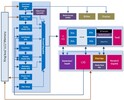Intel HD Graphics (Ivy Bridge) vs AMD Radeon R2 (Stoney Ridge) vs Intel HD Graphics 405 (Braswell)
Intel HD Graphics (Ivy Bridge)
► remove from comparison
Die Intel HD Graphics ist eine in den Ivy Bridge Prozessoren integrierte Grafikkarte. Sie kommt in den mobilen Celeron- und Pentium-Modellen zu Einsatz. Im Vergleich zur stärkeren Intel HD Graphics 4000, ist die HD Graphics deutlich abgespeckt und bietet weniger Execution Units (6 EUs) und Texture Sampler (nur einer). Daher ist die Performance deutlich geringer und liegt nur etwas oberhalb der alten Intel HD Graphics 2000. Je nach Prozessor weist die HD Graphics eine unterschiedliche Basis- und Turbo-Taktrate auf.
Da die Leistung nur zwischen der HD Graphics 2000 und 3000 liegt, ist die Ivy Bridge GT1 nur für ältere und anspruchslose Spiele ausreichend. Intel selbst gibt eine Geschwindigkeit 10-15% über der alten HD Graphics 2000 in Sandy Bridge CPUs an. Unsere Benchmarks (siehe weiter unten) zeigen eine Performance auf dem Niveau integrierter Einstiegslösungen von AMD wie der Radeon HD 8210.
Eine Besonderheit der Ivy Bride Grafikkerne ist, dass nur 4x MSAA von der Hardware unterstützt wird. 2x MSAA wird per Software berechnet und geht durch die 4x MSAA Pipeline. Daher empfiehlt sich der Einsatz des gleich schnellen 4x MSAA.
Auch der integrierte Videodecoder genannt Multi Format Codec Engine (MFX) wurde kräftig überarbeitet und soll nun sogar mehrere 4K Videos parallel dekodieren können (ev. nur in den High-End Modellen). DXVA Checker gibt weiterhin die Formate MPEG2, VC1, WMV9 und H264 als unterstützt an. QuickSync zum schnellen Transkodieren von Videos wurde ebenfalls verbessert und soll nun schneller bei gleichzeitig höherer Qualität laufen.
Ebenfalls neu ist die Unterstützung für drei unabhängige Bildschirme. Bis Sandy Bridge waren nur zwei möglich und lediglich die AMD Grafikkarten mit Eyefinity Support bieten mehr als zwei Anschlüsse für Notebooks (jedoch nur mit DisplayPort).
Aufgrund der Integration in den mit 22nm gefertigten Prozessor und die halbierte Shaderzahl ist der Stromverbrauch relativ gering und eignet sich auch für flache und kleine Notebooks.
AMD Radeon R2 (Stoney Ridge)
► remove from comparison
Die AMD Radeon R2 (Stoney Ridge) ist eine integrierte Grafikeinheit der schwächsten mobilen Stoney-Rdige-APUs. Sie kommt zum Launch im AMD E2-9010 zum Einsatz und bietet wahrscheinlich 128 Shader bei 600 MHz. Je nach konfigurierter TDP und eingesetztem Hauptspeicher kann die Leistung deutlich variieren.
Architektur und Features
Die Radeon R4 bietet zwei Kerne der dritten GCN Generation (in der Presse oft als GCN 1.2 oder 2.0 bezeichnet). Damit ist sie sehr ähnlich zu dem Tonga Desktop Chip und bietet DirectX 12 (FL 12_0) Hardware-Support. Weiters können auch per Mantle, OpenGL und OpenCL die Grafikkerne angesprochen werden. Außerdem unterstützt die Grafikkarte den HSA 1.0 Standard und kann damit effizient in Verbindung mit den CPU Kernen genutzt werden. Technisch entspricht die GPU exakt dem Vorgänger Carrizo.
Die Videoeinheit beinhaltet den UVD 6 (Unified Video Decoder), welcher HVEC/H.265 und 4K hardwareunterstützt dekodieren kann. Mehr Details dazu finden Sie in unserem Stoney-Ridge Artikel.
Leistungsaufnahme
Je nach Modell und konfigurierter TDP (cTDP) ist der in 28 nm gefertigte Chip mit 10 bis 15 Watt spezifiziert. Damit eignet er sich für den Einsatz in schlanken und leichten Notebooks.
Intel HD Graphics 405 (Braswell)
► remove from comparison
Die Intel HD Graphics 405 ist eine in den Low-End-SoCs der Braswell-Serie (z.B. Pentium N3710) integrierte Grafikeinheit. Sie basiert auf der gleichen Architektur wie die GPU verschiedener Broadwell-Prozessoren (z.B. HD Graphics 5300), bietet allerdings deutlich weniger Shadereinheiten und geringere Taktraten. Die genauen Spezifikationen hängen vom jeweiligen SoC ab: Die schnellste Variante mit 16 EUs und maximal 700 MHz schlägt die ältere HD Graphics (Bay Trail) um etwa Faktor zwei. Vor 2016 war die Grafikkarte nur unter Intel HD Graphics (Braswell) bekannt und beinhaltete 12 und 16-Kern-Modelle.
Anwender müssen sich deshalb insbesondere bei den Celeron-Modellen, die zusätzlich durch die Beschneidung auf nur zwei CPU-Kerne ausgebremst werden, auf ältere und anspruchslose Spiele beschränken. Videos werden dagegen auch in 4K/H.265 flüssig wiedergeben.
Weitere Benchmarks sind daher auch auf unserer Seite der Intel HD Graphics (Braswell) zu finden.
| Intel HD Graphics (Ivy Bridge) | AMD Radeon R2 (Stoney Ridge) | Intel HD Graphics 405 (Braswell) | ||||||||||||||||||||||||||||||||||||||||||||||||||||||||||||||||||||||||||||||||||||||||||||||||||||||||||||||||||||||||||||||||||||||||||||||||||||||||||
| HD Graphics Serie |
|
|
| |||||||||||||||||||||||||||||||||||||||||||||||||||||||||||||||||||||||||||||||||||||||||||||||||||||||||||||||||||||||||||||||||||||||||||||||||||||||||
| Codename | Ivy Bridge GT1 | Stoney Ridge | Braswell | |||||||||||||||||||||||||||||||||||||||||||||||||||||||||||||||||||||||||||||||||||||||||||||||||||||||||||||||||||||||||||||||||||||||||||||||||||||||||
| Architektur | Gen. 7 Ivy Bridge | GCN 1.2/2.0 | Gen. 8 | |||||||||||||||||||||||||||||||||||||||||||||||||||||||||||||||||||||||||||||||||||||||||||||||||||||||||||||||||||||||||||||||||||||||||||||||||||||||||
| Pipelines | 6 - unified | 128 - unified | 16 - unified | |||||||||||||||||||||||||||||||||||||||||||||||||||||||||||||||||||||||||||||||||||||||||||||||||||||||||||||||||||||||||||||||||||||||||||||||||||||||||
| Kerntakt | 350 - 1100 (Boost) MHz | 600 (Boost) MHz | 320 - 700 (Boost) MHz | |||||||||||||||||||||||||||||||||||||||||||||||||||||||||||||||||||||||||||||||||||||||||||||||||||||||||||||||||||||||||||||||||||||||||||||||||||||||||
| Speicherbandbreite | 64/128 Bit | 64 Bit | 64/128 Bit | |||||||||||||||||||||||||||||||||||||||||||||||||||||||||||||||||||||||||||||||||||||||||||||||||||||||||||||||||||||||||||||||||||||||||||||||||||||||||
| Shared Memory | ja | ja | ja | |||||||||||||||||||||||||||||||||||||||||||||||||||||||||||||||||||||||||||||||||||||||||||||||||||||||||||||||||||||||||||||||||||||||||||||||||||||||||
| API | DirectX 11.0, Shader 5.0 | DirectX 12 (FL 12_0), OpenGL 4.4 | DirectX 11.2, Shader 5.0 | |||||||||||||||||||||||||||||||||||||||||||||||||||||||||||||||||||||||||||||||||||||||||||||||||||||||||||||||||||||||||||||||||||||||||||||||||||||||||
| Herstellungsprozess | 22 nm | 28 nm | 14 nm | |||||||||||||||||||||||||||||||||||||||||||||||||||||||||||||||||||||||||||||||||||||||||||||||||||||||||||||||||||||||||||||||||||||||||||||||||||||||||
| Erscheinungsdatum | 01.10.2012 | 01.06.2016 | 01.04.2016 | |||||||||||||||||||||||||||||||||||||||||||||||||||||||||||||||||||||||||||||||||||||||||||||||||||||||||||||||||||||||||||||||||||||||||||||||||||||||||
| Stromverbrauch | 15 Watt | |||||||||||||||||||||||||||||||||||||||||||||||||||||||||||||||||||||||||||||||||||||||||||||||||||||||||||||||||||||||||||||||||||||||||||||||||||||||||||
| Transistors | 3.1 Billion | |||||||||||||||||||||||||||||||||||||||||||||||||||||||||||||||||||||||||||||||||||||||||||||||||||||||||||||||||||||||||||||||||||||||||||||||||||||||||||
| Features | UVD 6, VCE |
|
|
| ||||||||||||||||||||||||||||||||||||||||||||||||||||||||||||
Benchmarks
3DM Vant. Perf. total + Intel HD Graphics (Ivy Bridge)
specvp11 snx-01 + Intel HD Graphics (Ivy Bridge)
Cinebench R15 OpenGL 64 Bit + AMD Radeon R2 (Stoney Ridge)
GFXBench T-Rex HD Offscreen C24Z16 + Intel HD Graphics (Ivy Bridge)
Average Benchmarks Intel HD Graphics (Ivy Bridge) → 100% n=16
Average Benchmarks AMD Radeon R2 (Stoney Ridge) → 162% n=16
Average Benchmarks Intel HD Graphics 405 (Braswell) → 129% n=16
* Smaller numbers mean a higher performance
1 This benchmark is not used for the average calculation
Spiele-Benchmarks
Die folgenden Benchmarks basieren auf unseren Spieletests mit Testnotebooks. Die Performance dieser Grafikkarte bei den gelisteten Spielen ist abhängig von der verwendeten CPU, Speicherausstattung, Treiber und auch Betriebssystem. Dadurch müssen die untenstehenden Werte nicht repräsentativ sein. Detaillierte Informationen über das verwendete System sehen Sie nach einem Klick auf den fps-Wert.

Hearthstone
2020
League of Legends
2019
Team Fortress 2
2017
Rocket League
2017
Resident Evil 7
2017
Titanfall 2
2016
Farming Simulator 17
2016
Civilization VI
2016
Overwatch
2016
Rainbow Six Siege
2015
Anno 2205
2015
World of Warships
2015
Metal Gear Solid V
2015
Dota 2 Reborn
2015
Dirt Rally
2015
Battlefield Hardline
2015
F1 2014
2014
Alien: Isolation
2014
Sims 4
2014
Risen 3: Titan Lords
2014
GRID: Autosport
2014
Thief
2014
X-Plane 10.25
2013
Battlefield 4
2013
F1 2013
2013
Fifa 14
2013
Dota 2
2013
GRID 2
2013
Metro: Last Light
2013
BioShock Infinite
2013
Tomb Raider
2013
Dead Space 3
2013
Hitman: Absolution
2012
Dishonored
2012
Fifa 13
2012
F1 2012
2012
Guild Wars 2
2012
Counter-Strike: GO
2012
Dirt Showdown
2012
Diablo III
2012
Anno 2070
2011
Fifa 12
2011
Dirt 3
2011
StarCraft 2
2010Average Gaming Intel HD Graphics (Ivy Bridge) → 100%
Average Gaming 30-70 fps → 100%
Average Gaming AMD Radeon R2 (Stoney Ridge) → 147%
Average Gaming 30-70 fps → 146%
Average Gaming Intel HD Graphics 405 (Braswell) → 118%
Average Gaming 30-70 fps → 110%
| Intel HD Graphics 405 (Braswell) | low | med. | high | ultra | QHD | 4K |
|---|---|---|---|---|---|---|
| Hearthstone | 17.8 | 18 | 9.91 | |||
| League of Legends | 23.6 | 18 | 13.9 | |||
| PUBG Mobile | ||||||
| World of Tanks Blitz | 37 | 24 | ||||
| Arena of Valor | 25 | |||||
| Shadow Fight 3 | 30 | |||||
| Battle Bay | 37 | |||||
| Team Fortress 2 | 19.6 | |||||
| Rocket League | 18.7 | |||||
| Resident Evil 7 | 13.5 | 11 | ||||
| Titanfall 2 | 14.4 | 10.5 | ||||
| Farming Simulator 17 | 24 | 21.3 | ||||
| Civilization VI | 12.2 | 5.2 | ||||
| Mirror's Edge Catalyst | 10.5 | 6.1 | ||||
| Rise of the Tomb Raider | 7.1 | 4.2 | ||||
| Rainbow Six Siege | 15.3 | 8.9 | ||||
| Anno 2205 | 10.8 | 6.9 | ||||
| World of Warships | 18 | 16.2 | ||||
| Metal Gear Solid V | 18.8 | 13 | ||||
| Dota 2 Reborn | 29 | 18 | ||||
| Dirt Rally | 41.5 | 12.5 | ||||
| Dragon Age: Inquisition | 12.1 | 7.6 | ||||
| F1 2014 | 28 | 17 | ||||
| Alien: Isolation | 18.9 | 13.6 | ||||
| Sims 4 | 77.5 | 19.6 | ||||
| Risen 3: Titan Lords | 14 | 9.1 | ||||
| GRID: Autosport | 50.5 | 15 | ||||
| Thief | 6 | |||||
| Battlefield 4 | 16.5 | 12.5 | 8.3 | |||
| BioShock Infinite | 20 | 11 | 10 | |||
| Tomb Raider | 27.8 | 12.8 | 9.5 | |||
| Dead Space 3 | 43.2 | 19.6 | 14.3 | |||
| Counter-Strike: GO | 42.6 | 32 | 20.4 | |||
| Diablo III | 32 | 19.1 | 14.4 | |||
| The Elder Scrolls V: Skyrim | 21.8 | 10.4 | 6.5 | |||
| Deus Ex Human Revolution | 35.4 | 14.7 | ||||
| < 30 fps < 60 fps < 120 fps ≥ 120 fps | 25 8 1 | 26 1 | 11 1 | | | |
| AMD Radeon R2 (Stoney Ridge) | low | med. | high | ultra | QHD | 4K |
|---|---|---|---|---|---|---|
| Team Fortress 2 | 19.7 | 18.5 | ||||
| Rocket League | 30.8 | |||||
| Prey | 9.4 | |||||
| Farming Simulator 17 | 43.5 | 26.4 | ||||
| Civilization VI | 21.6 | 8.5 | ||||
| Overwatch | 17.5 | 15 | ||||
| Rainbow Six Siege | 20.4 | 13.8 | ||||
| World of Warships | 25.5 | 20.3 | ||||
| Metal Gear Solid V | 23.6 | 18.5 | ||||
| Dota 2 Reborn | 28.7 | 18.4 | ||||
| Dirt Rally | 25.1 | 13 | ||||
| Battlefield Hardline | 6.7 | 4.9 | ||||
| Dragon Age: Inquisition | 11.2 | 8.7 | ||||
| F1 2014 | 28 | 18 | ||||
| Alien: Isolation | 17.8 | 10.3 | ||||
| Sims 4 | 82.1 | 20.7 | ||||
| Risen 3: Titan Lords | 14.1 | 8.7 | ||||
| GRID: Autosport | 46 | 16.9 | ||||
| GRID 2 | 39.5 | 20.7 | 12.6 | |||
| BioShock Infinite | 34 | 17 | 14 | |||
| Tomb Raider | 35.7 | 15.7 | 11.1 | |||
| Dead Space 3 | 43.5 | 20.8 | 16.5 | |||
| Counter-Strike: GO | 26.9 | 21.7 | 20 | |||
| Diablo III | 28.5 | 17.8 | 15.9 | |||
| Anno 2070 | 48.8 | 22.3 | 13.9 | |||
| The Elder Scrolls V: Skyrim | 24.7 | 16.3 | 10.8 | |||
| Deus Ex Human Revolution | 41 | 20.3 | ||||
| Dirt 3 | 55.7 | 28.1 | 22.1 | |||
| StarCraft 2 | 59.6 | 17.8 | 14.1 | |||
| World of Warcraft | 65.2 | 33.2 | ||||
| < 30 fps < 60 fps < 120 fps ≥ 120 fps | 17 11 2 | 26 1 | 11 | | | |
| Intel HD Graphics (Ivy Bridge) | low | med. | high | ultra | QHD | 4K |
|---|---|---|---|---|---|---|
| The Elder Scrolls Online | 34.5 | 14.3 | 8.6 | |||
| Thief | 5.9 | 3.6 | ||||
| X-Plane 10.25 | 15 | 7.6 | ||||
| F1 2013 | 20 | 14 | ||||
| Fifa 14 | 54.4 | 32 | ||||
| Dota 2 | 24 | 16 | ||||
| GRID 2 | 27.54 | 12.84 | 12.5 | |||
| Metro: Last Light | 10.52 | 8.09 | 4.35 | |||
| BioShock Infinite | 17 | 9 | 7.72 | |||
| StarCraft II: Heart of the Swarm | 96 | 22 | 13 | 4 | ||
| Tomb Raider | 20 | 11 | 7 | |||
| Dead Space 3 | 42 | 17 | 12 | 6 | ||
| Hitman: Absolution | 13 | 11 | 4 | |||
| Dishonored | 19 | 15 | ||||
| Fifa 13 | 58 | 36 | 20 | 13 | ||
| F1 2012 | 23 | 19 | 16 | 12 | ||
| Guild Wars 2 | 30 | 8 | 5 | |||
| Counter-Strike: GO | 37 | 20 | 11 | |||
| Dirt Showdown | 36 | 13 | ||||
| Diablo III | 29.2 | 17.5 | 14.6 | |||
| Anno 2070 | 26 | 12 | 8 | |||
| The Elder Scrolls V: Skyrim | 16 | 9 | 4.55 | |||
| Fifa 12 | 55.8 | 21.2 | ||||
| Deus Ex Human Revolution | 25.4 | 11.4 | ||||
| Dirt 3 | 41.4 | 16.5 | ||||
| Trackmania Nations Forever | 90 | 20.7 | ||||
| World of Warcraft | 78.3 | 28.3 | ||||
| < 30 fps < 60 fps < 120 fps ≥ 120 fps | 15 6 3 | 20 4 | 18 1 | 6 | | |
Eine Liste mit weiteren Spielen und allen Grafikkarten finden Sie auf unserer Seite: Welches Spiel ist mit welcher Grafikkarte spielbar?



























